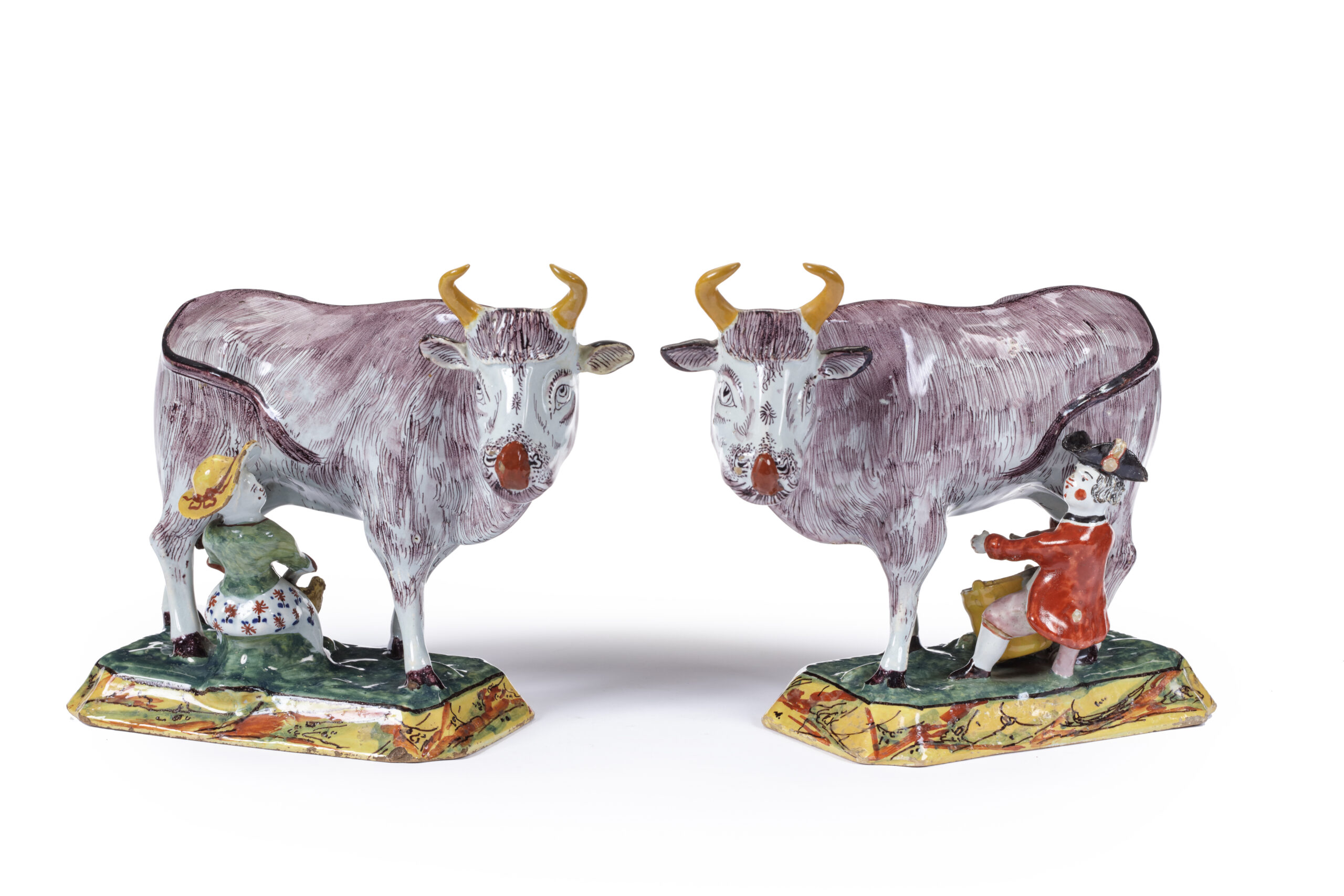[popup_trigger id=”13756″ tag=”span”]![]() [/popup_trigger]
[/popup_trigger]
Images on this website are licensed under a
Creative Commons Attribution-NoDerivs 3.0 Unported License.
OBJECT
•D2218. Pair of Polychrome Milking Groups
Delft, circa 1780
Marked YvDuijn in manganese for IJsbrand van Duijn, the owner of De Porceleyne Schotel (The Porcelain Dish) factory from 1773 to 1791
Modeled affronté, each cow’s hide finely delineated in manganese, manganese eyes, muzzle and forelock, ears and hooves and yellow horns, wearing garlands of iron- red, yellow and manganese flowers and green leaves around its neck and back, standing foursquare and being milked by a maid wearing a yellow hat, a green bodice and floral patterned white skirt or a youth wearing an iron-red coat and pale pink breeches and manganese hat, each seated with a pail between her or his feet at the front of the chamfered rectangular high base, its canted sides marbleized in yellow, green, iron-red and manganese, and its green top molded with frogs and leaves.
DIMENSIONS
Width: 22.5 cm. (8.9 in.)
NOTE
Cows are the most famous and beloved subjects depicted in Dutch Delftware. Since the eighteenth century they have adorned mantelpieces, furniture and window sills. They were always produced in pairs, with their heads turned towards each other and tongues lapping.
The Delft potters were inspired by a seventeenth-century tradition. Each year the Butcher’s guild in Holland would hold a parade on the day of its patron saint, St. Luke, symbolized by the apocalyptic winged ox. The parade celebrated the guild’s best- bred bull or cow. The prized beast was decorated with floral garlands and ribbons, and gilded horns that were often topped with oranges. The festive, bannered procession was led by drummers and pipers, followed by a singing and dancing chorus of guild members and townspeople. The animal would later be butchered and the meat served at the guild dinner, a portion of it being donated to the church and the local poor. From this tradition emerged the saying, ‘The guild ox is on parade’, which became synonymous with ‘this is a real feast!’ A century later, the guild’s tradition lived on in the imagery of Delftware cows.
A description about a Butcher’s Guild parade in De Volksvermaken (The People’s Pleasures) by Jan ter Gouw in 1871 offers a realistic account of the animals’ decorative flourishes, which are remarkably similar to the imagery on most of the Delftware cows. “The beast was draped with flowers and wreaths and its horns gilded; the drums and pipes came first; the guild banner was blowing in the air, the guild brothers cheerfully marched around it, and the townspeople followed along with humming and singing.” Ter Gouw provides further insight as to why the decorated ox remained an important tradition even in later centuries: “When the parading of the guild-ox was discontinued by the guilds, the butchers themselves kept the tradition alive for a long time. When they had bought an especially large or fat animal, they would garland it with flowers and lead it around the town, accompanied by drums, so that all who saw the ample beast, would order a piece from it; and even though no guild was still related to the custom, the event kept its name because it was associated with something excellent.”
The present pair of milking groups is slightly larger than most of the other milking groups known. The milkers on the present pair are seated beside a pail and accompanied by frogs molded in the green top of the base. Toads and snakes are commonly seen modeled in relief on the bases of these forms. The toad can be seen as an allegory of death, emphasizing the probable brevity of this domestic beast’s useful life. Furthermore, the Dutch proverb ‘There lurks a snake in the grass,’ which means that there is a risk hidden in the game, may relate to the imagery of the snake. This is probably a reference to the cruel fate of the cow, that is now adorned in beautiful garland but will soon be slaughtered. In the 1627 Sinne- en minnebeelden by the Dutch poet Jacob Cats (1577- 1660), a print depicting a Butcher’s Guild parade is illustrated with an accompanying metaphorical poem. It relates the ox, well-fed and beautifully decorated, but about to be slaughtered, to the dissolution of prosperity.









